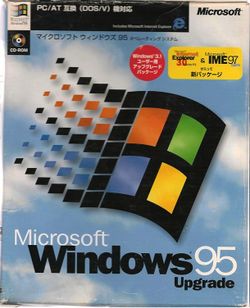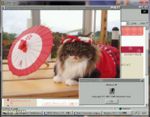Windows 95
| Windows 95 | |
 A retail copy of Windows 95 from Japan | |
| Type: | single user environment |
|---|---|
| Creator: | Microsoft |
| Multitasking: | preemptive for 32 bit processes, cooperative for 16 bit processes, with paging (386) |
| Architecture: | i386 |
| Date Released: | 1995 |
Windows 95 was Microsoft's first consumer hybrid 32-bit operating system. While many of its internals were 16-bit, and a significant amount of it was based on the older Windows 3.1, Windows 95's capabilities surpassed those of, say, Windows 3.1 with Win32s.
Windows 95 also revolutionized the PC interface by switching from the program manager to the explorer desktop shell. While it wasn't an object desktop like OS/2's presentation manager, it was a good enough facsimile. Windows 95 was significantly easier for first time users to operate, and it was wildly popular for the user interface alone.
Windows 95 was able to execute threads, shipped with TCP/IP, and IPX/SPX stack for Novell Netware, and had a variety of 32-bit device drivers. However for compatibility it could 'fall back' and use various 16-bit drivers.
Windows 95 was updated multiple times. The most significant update was OSR2, short for OEM Service Release 2, and was released in 1996. At the time Windows 95 was first released, it was limited to the FAT 16 file system, so partitions could not go beyond 2 gigabytes. OSR2 added support for FAT32 so that new systems could support much larger partitions with less wasted space. Boxed retail copies of Windows 95 were never updated to OSR2, so FAT32 support was only available with an OEM supplied copy of Windows 95. Windows 98 included FAT32 in a retail box, along with tools for converting existing systems to use it, which OSR2 did not include.
Microsoft also started to sell add-ons for its consumer operating systems starting with the Plus Pack! that included Internet Explorer and various system enhancers in the form of better disk compression, a system agent (think of cron) and themes.
It is worth noting that this was the most significant upgrade ever delivered into the PC market place. The transition of going from the 16 bit environment of Windows 3.1, to a 32-bit environment has allowed for a far greater user experience. This is because of the combination of faster CPUs and larger main memory spaces.
Getting this to run
For machines with fast CPUs, take a look here: msfn.org
| v • d • e Microsoft Windows Versions, Vendors and Related |
|---|
| 16 bit - Windows 1.0 • Windows 2.0 • Windows 3.0 • Windows 3.1 • Windows 3.2
Hybrid 32/16 bit - win32s • Windows 95 • Windows 98 • Windows ME 32 bit - Windows NT 3.1 • Windows NT 3.5 • Windows NT 3.51• Windows NT 4.0 |
